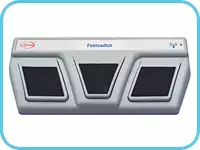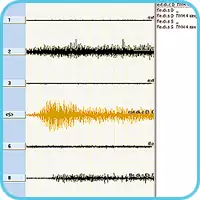Neuromyoanalyzer NMA-4-01 "Neuromyan"
for electromyographic studies and for studies of evoked potentials
 Present-day development of electronics and wireless technologies provides quality record of myographic signals and evoked potentials, and guarantees comfort for a doctor during studies carrying out.
Present-day development of electronics and wireless technologies provides quality record of myographic signals and evoked potentials, and guarantees comfort for a doctor during studies carrying out.
2, 4 or 5-channel modifications or different software versions provide both inexpensive and elite expert class devices.
Meant for use in neurological and neurophysiological departments, sport medicine and scientific research.
Wireless connection of patient transceiver-recorder with remote controller, pattern-stimulator and footswitch decreases the number of wire connections and increases comfort for patients and doctors during study carrying out.
Components and technical characteristics
 Wide range of functional capabilities is determined by combination of software variants and neuromyograph's modification.
Wide range of functional capabilities is determined by combination of software variants and neuromyograph's modification.
Main technical characteristics:
- 2, 4 or 5 galvanically insulated EMG and EP amplifiers;
- USB interface for PC communications;
- Wireless interface to control footswitch, remote controller and chess pattern generator;
- Generators of photo-, phono- and electrostimulation signals;
- In/out of synchronization for connection of magnetic stimulator and other devices;
- Sampling rate – up to 200 kHz per channel;
- AD converter – 16 bit;
- Sensitivity: 0,2 – 10 000 μV /grade (15 grades);
- Input impedance: 100/20 MΩ / pF;
- Noise level maximum 0,6 μV within the frequency band 10 Hz – 10 kHz;
- Disconnectable adaptive filter of power line disturbances;
- Common mode rejection ratio minimum 110 dB at 50 Hz frequency;
- Passband lower limit : 0,01 – 300 Hz;
- Passband upper limit: 10 Hz – 20 kHz.
 Wireless connection of patient transceiver-recorder with remote controller, pattern-stimulator and footswitch decreases the number of wire connections and increases comfort for patients and doctors during study carrying out.
Wireless connection of patient transceiver-recorder with remote controller, pattern-stimulator and footswitch decreases the number of wire connections and increases comfort for patients and doctors during study carrying out.
Remote controller (RC)
Not using a PC mouse and a keyboard simplifies carrying out repeated standard studies:
- Functions as a traditional keyboard of neuromyograph and electrostimulator's handle at the same time;
- "Quick start" of a new examination program using RC speeds up the analysis of combined and symmetrical nerves and muscles;
- Buttons and wheel-regulator of RC are of different functional purpose for each examination program, which allows optimizing main actions carrying out.
 Wireless footwitch:
Wireless footwitch:
- Use of a wireless footswitch simplifies a myographic study progress;
- Switch allows controlling data record modes and stimulation, making doctor's hands free for electrode manipulations.
Sensors and electrodes:
- Surface electrodes with fixed interelectrode distance;
- Electrode with grounding cable;
- Stimulating electrode with felt pads (for children and adults);
- EP differential cable;

- EP cable with 2 channels and common referent;
- EP cable with 3 channels and common referent;
- Shielded cable for disposable needle electrodes;
- Disposable concentric needle electrode;
- EMG/EP cup electrodes;
- Stimulation electrode with steel stimulation point (for children and adults);
- Stimulating bar electrode with felt pads.
Options for delivery set:
- Reflex hammer;
- Skin temperature sensor;
- Audiometric headphones TDH-39;
- Magnetic stimulator for diagnostics and therapeutic treatment of motor cortex zone, stimulation of spinal cord and peripheral nerve system.
Please contact us to receive full quotation, catalogues and price-list with your personal conditions.
Mail: This email address is being protected from spambots. You need JavaScript enabled to view it.
Skype: tenmed1
Electromyographic studies
Rejection algorithm of stimulation artifacts provides record of short nerves responses.
Integral tables display the quantity and results of tests carried out, which allows a doctor to define the necessity of carrying out and selection of further tests.
- Motor conduction velocity (MCV)
- Sensory conduction velocity (SCV)
- F-wave
 |
 |
 |
| Motor conduction velocity (MCV) | Sensory conduction velocity (SCV) | F-wave |
The library of nosologically oriented study strategy saves time for typical studies.
- One-channel surface EMG
allows studying greater number of muscle using different loads. - Needle EMG
provides record of injection coefficient, spontaneous activity, Motor Unit Potential and interference pattern.
Multichannel surface EMG allows studying mutual work of a muscle group, calculating reciprocal, synergic and adequacy coefficients.
 |
 |
| Surface EMG-express | Needle EMG |
Rhythmic stimulation allows creating stimulation scenarios and perform them in manual and autonomous modes.
- Blink reflex
Visual graphic form of results presentation displays the damage level. - H-reflex
 |
 |
| Blink reflex | H-reflex |
Evoked potential studies
 Study of visual EP for chess pattern
Study of visual EP for chess pattern
SW chess pattern generator is attached onto the backside of additional monitor with standard mount VESA.
Main characteristics of a stimulator:
- Filling the monitor with chess board with cells from 2х2 to 96х128 and angle sizes from 8° to 7,5′;
- Field of pattern presentation: full screen, a half, a quarter, central part;
- Graph forms of a reverse pattern: chess board, vertical or horizontal stripes;
- Frequency of pattern element switch within the range 1-16 reverses per second;
- Movable fixation point within the screen area.
Additional monitor can be used as a second monitor Windows for comfortable placing of signal windows, tables, etc.
Auditory EP studies
- Short-latency evoked potentials (SAEP)
- Medium-latency evoked potentials (MAEP)
- Long-latency evoked potentials (LAEP)
- Stimulus type: click, harmonic tone with a square or trapezoid envelope;
- Stimulus intensity (SPL): 1 – 110 dB;
- Control: independent by right and left channels;
- Contralateral noise masking.
Comfortable semi-automatic algorithm of individual hearing threshold selection.
Specially calibrated stereo headphones are used as phonostimulator
 |
 |
 |
| Short-latency evoked potentials of a brainstem (SAEP) |
Medium-latency evoked potentials (MAEP) |
Long-latency evoked potentials (LAEP) |
Flash visual EP studies
Photostimulation is performed with specified LED goggles.
- Stimulation field brightness: 2250±750 cd/m²;
- Flashes repetitive frequency is within the range: 0,2 - 1,6 Hz;
- Flash duration: 1,0±0,1 msec.
Corresponds to ISCEV (International Society for Clinical Electrophysiology) "Visual evoked potentials standard".
Somatosensory EP studies
- Short-latency somatosensory evoked potentials (SSEP)
- Long-latency somatosensory evoked potentials (LSEP)
 |
 |
| Flash visual EP studies | Somatosensory EP studies |
Please contact us to receive full quotation, catalogues and price-list with your personal conditions.
Mail: This email address is being protected from spambots. You need JavaScript enabled to view it.
Skype: tenmed1


